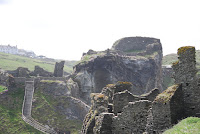 Shwmae all,
Shwmae all, The weather is supposed to be good so we head off to explore Erddig a stately home just over the border of Wales just a hour away. The weather threatens off and on as we travel but the sun is out by the time we arrive. Built in 1684-1687 for Josiah Edisbury the High Sheriff of Denbighshire and designed by Thomas Webb a freemason of Cheshire. A grade 1 listed building and voted the UK's most favourite historic house in 2007 . Sadly it fell into deep disrepair so for us we have seen more elaborate homes on our travels.
We have lunch in the cafe before setting off to explore the house itself.We enter the house thru the stables and workshop which has been home to the Yorke family for 200 years. Sold to the master of Chancery, John Meller in 1714 he enlarged the house adding two wings in the 1720's. He died unmarried with no heirs in 1733 and the home passed down to his nephew Simon Yorke and remained in the family till March 1973 when it was given to the National Trust. Collapse of a mine shaft under the home made the structure unstable and 120,000 pounds of NT funding shored up the structure. Lands surrounding the home were sold to The National Coal board for 995,000 pounds which helps with the total restoration of the house which over time had fell into disrepair.
The Yorke family were either very thrifty or hoarders as they rarely threw anything away so there are over 30,000 objects in the property. From carriages to old cars , tools to new inventions of the time are on display and tell a story of each generation of the family.
The picture on the left is of a early vacuum cleaner that is operated by stepping on the plates to generate suction so you can suck up the dirt and dust. Called a Witch Dust Extractor not only would the maid clean up the dust but also get a major workout. The lower level of the house is quite plain and somewhat dull but also had pictures of the servants and poems the master of the house had written about them. The servants here were treated more as family then workers and were allowed to mix among themselves outside their stations which apparently was a big no no. Something I was not aware of as I assumed a servant was a servant however even they had a class structure.
Pictured on the right is one of the few rooms that was spared damage . The green Chinese wall paper and ornate Chinese writing cabinet along with a bed that has been restored. The room is now hermetically sealed with a special glass casing the controls the air and humidity so no further damage can occur.
We now explore the gardens while still have a amazing amount of flowers in bloom. The gardens are one of the most important surviving 18th century formal gardens in Britain . I stop and speak to a gardener who is trimming Yews in a specific shapes with garden shears. I ask him how long it takes him and he replies too long. A full day he gets about six yews done and these are all hand trimmed not using any modern electric trimmers. What a painstaking job but the trees look beautiful and are all shaped to such a exactness.
There are over 180 varieties of apples on the estate as well as other rare fruit trees , pond, a channel, a Victorian parterre, and a Ivy collection. While walking through the gardens a mallard starts to
follow Fred, he sits down on the bench to enjoy the sun and view and the duck walks right up to him looking for food. Very tame but sadly we have nothing to feed the hungry guy.
It has been a lovely day and has been much better then sitting around at home doing nothing . The last shot is of the view that the Yorkes had from the front of their house looking over the welsh countryside.
 Check out my Facebook wall to see more pictures of Erddig.
Check out my Facebook wall to see more pictures of Erddig.We hope you have enjoyed this little tale of Erddig,
Hwyl fawr,
Sandy & Fred
















































